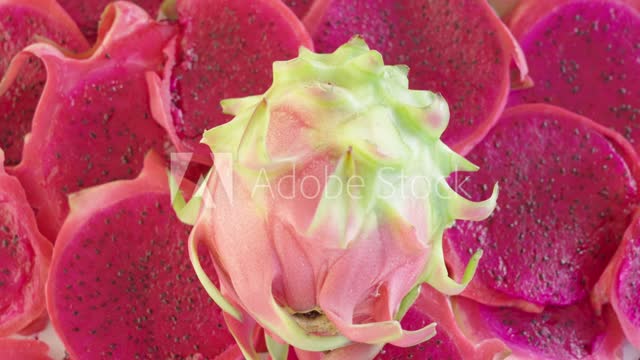Premium Only Content

Dragon fruit: Is it the next big thing in Indian horticulture
The dragon fruit, which is indigenous to the Americas, can grow in arid and semi-arid regions with very low input cost
The dragon fruit (Hylocereus undatus) is indigenous to the Americas. Its name comes from its appearance — leather-like skin and scaly spikes on the exterior of the fruits. It is also known as ‘Pitaya’, ‘Pitahaya’, strawberry pear, noblewoman and queen of the night throughout the world.
The dragon fruit was introduced to home gardens in India in the 1990s. It gained wider popularity among farmers due to its profitability and the fact that it needed lower inputs once established. The plant sustains yield for more than 20 years, is high in nutraceutical properties and good for value-added processing industries.
The low maintenance and high profitability of dragon fruits has attracted the farming community throughout India. This has led to a steep increase in dragon fruit cultivation in Maharashtra, Karnataka, Andhra Pradesh, West Bengal, Telangana, Tamil Nadu, Odisha, Gujarat and the Andaman and Nicobar Islands, as well as in many north eastern states.
A recent estimate by Indian Council of Agricultural Research-National Institute of Abiotic Stress Management, Baramati in Maharashtra found that dragon fruits are cultivated on 3,000-4,000 hectares in various states of India. The country produces approximately 12,000 tonnes of the fruit every year.
By Vijaysinha Kakde, Sangram B Chavan , Vanita Salunkhe
Published: Monday 19 July 2021
The dragon fruit (Hylocereus undatus) is indigenous to the Americas. Its name comes from its appearance — leather-like skin and scaly spikes on the exterior of the fruits. It is also known as ‘Pitaya’, ‘Pitahaya’, strawberry pear, noblewoman and queen of the night throughout the world.
The dragon fruit was introduced to home gardens in India in the 1990s. It gained wider popularity among farmers due to its profitability and the fact that it needed lower inputs once established. The plant sustains yield for more than 20 years, is high in nutraceutical properties and good for value-added processing industries.
The low maintenance and high profitability of dragon fruits has attracted the farming community throughout India. This has led to a steep increase in dragon fruit cultivation in Maharashtra, Karnataka, Andhra Pradesh, West Bengal, Telangana, Tamil Nadu, Odisha, Gujarat and the Andaman and Nicobar Islands, as well as in many north eastern states.
A recent estimate by Indian Council of Agricultural Research-National Institute of Abiotic Stress Management, Baramati in Maharashtra found that dragon fruits are cultivated on 3,000-4,000 hectares in various states of India. The country produces approximately 12,000 tonnes of the fruit every year.
The fruit can be exported to Persian Gulf countries, the European Union and the United States. In June 2021, India exported its first consignment of dragon fruit from a farmer of Maharashtra to Dubai in the United Arab Emirates.
The dragon fruit plant is a member of the cacti family. It is hardy and grows in diverse climatic conditions with varied soils, especially in the semi-arid and arid regions of India. It prefers slightly acidic soil and can tolerate some salts in soil too.
Package of practices
Dragon fruit is a fast-growing, semi-epiphytic vine that requires vertical pole-like support with a ring at the top.
AboutUs About us https://bit.ly/3GUPFOa
Contact us +919942258153 kvk.subadhra@gmail.com
Thank You Very Much for Sharing YourValuable Thoughts
https://8340c74f3g81q1f9pm9cnkviq2.hop.clickbank.net
-
 UPCOMING
UPCOMING
Graham Allen
1 hour agoDOGE Is Going After The IRS!! Mass Firing Soon!! + ANOTHER Plane Crash! We Are Not Safe…
1.48K -
 LIVE
LIVE
Chicks On The Right
3 hours agoCrazy plane crash, crazy lib protests, and Deborah Birx can suck it
2,051 watching -

Game On!
15 hours ago $1.62 earnedPresident Trump's plan to Make the Super Bowl Great Again!
8.26K -
 1:00:33
1:00:33
inspirePlay
14 hours ago $2.86 earned🏌️♂️ 3 Joes vs 1 Pro Golfer – You Won’t Believe This Ending! 🤯🔥
23.3K -
 20:47
20:47
MTNTOUGH Fitness Lab
21 hours agoDELAYED: Kyrgyzstan Ibex Hunt | A MTNTOUGH Original
25.2K -
 59:50
59:50
Trumpet Daily
21 hours ago $6.04 earnedThe End of the Trans-Atlantic Alliance - Trumpet Daily LIVE | Feb. 17, 2025
21.8K20 -
 52:05
52:05
PMG
12 hours ago $1.54 earnedWhat Does Freedom Cost? Steven Solomon's On-the-Ground Documentary in Ukraine
21.3K -
 2:38:54
2:38:54
TimcastIRL
13 hours agoElon Secret Child Scandal ERUPTS, Ashley St. Clair Story Goes Viral w/Bethany Mandel | Timcast IRL
194K126 -
 2:04:52
2:04:52
Kim Iversen
15 hours agoElon's Pumping Out Babies Like They're Tesla Model 3's | EU Panics Over Peace Talks, Wants More War
183K193 -
 1:05:35
1:05:35
Man in America
18 hours agoFort Knox & Trump’s Secret Gold Move—The Financial Reset NO ONE Is Ready For?
129K136